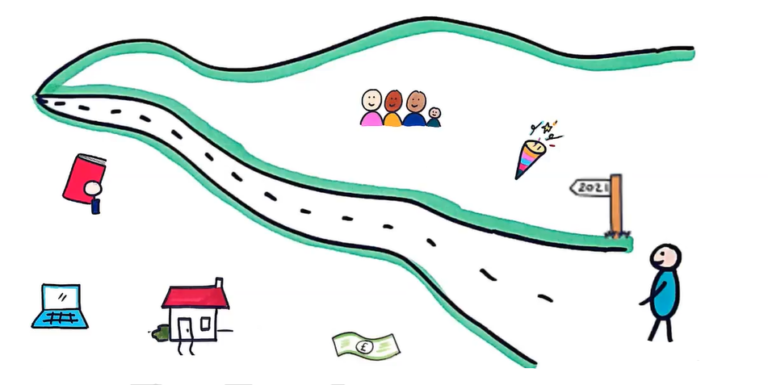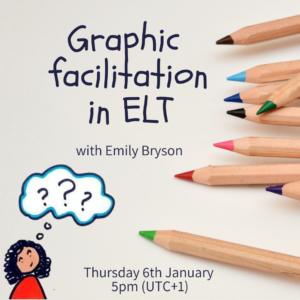Emily Bryson joined us to share how graphic facilitation – using simple visuals with our learners – can really help with communication in the classroom and beyond. Emily uses simple graphics in a huge variety of ways: doing social media posts, lesson planning, making Christmas or birthday cards, getting students to reflect – there are lots of ideas on her blog for how to include more graphics.
After a quick introduction (using visuals, of course!), Emily shared her ideas as to why drawing is such a handy skill for the classroom:
- it aids memory
- it’s great for facilitating peer feedback and checking understanding
- it’s supportive and stimulating
- it uses your whole brain
- it’s fun 😁
As Emily mentioned, it’s particularly useful for students who are perhaps illiterate in their own language or who are learning the Roman script alongside learning English. It’s also great for helping develop fine motor skills and building your students’ visual vocabulary. You can start with very simple, basic icons and then build on them to develop a visual dictionary.
Feel the fear and draw anyway
There are a lot of visual templates available online as well as the Noun Project which has a huge bank of simple icons. The quality of the drawing is less important than the communication of the idea, so Emily says you shouldn’t worry about creating a perfect visual representation of something. Emily shared a couple of activities to highlight how much more visually appealing notes and the whiteboard can be incorporating drawings into them.
In terms of drawing during the lesson, Emily mentioned using a visualiser, an app called CamScanner or using a whiteboard or flipchart – the benefit of which is that you can reuse some pages, such as your classroom rules.
Then we went on to try out some activities. This one on the right is a simple relfection activity that students can use to think about different things that happened to them in the previous year. Alternatively, you could change the date on the signpost and use it as a looking forward task for students to think about what they hope to achieve this year. On Zoom, students could annotate the image or you could share it on Jamboard and have them add sticky notes for each point. Emily also suggested giving them more choice: allowing them to choose which areas they would like to reflect on or giving them the topics and having them design their own icons.

Another template she shared was for students to think about goals for the year and then their bigger dreams and ambitions. Again, very simple with a bullseye (circles) and then arrows or stars. She also showed a stepping stones template to think about one goal and what you need to do to get there.
We did some drawing then, with Emily highlighting how all drawings are made up of simple lines and squiggles. She noted that the alphabet is made up of lines and squiggles, so if you can write the alphabet, you can draw 😁 And as she says, when you do something for the first time, it’s unlikely to be amazing, but with a little bit of practice, your icons will become much easier and quicker to draw. We looked at drawing a couple of animals and then thought about some classroom icons, such as a lightbulb, reflection, read, listen, write and so on.
Emily is running a six-week course to help teachers and other ELT professionals to develop their graphic facilitation skills and it’s filled with live sessions, video tutorials, tutor support and lots of practical ideas for the classroom. The next course is starting Monday 17th January, but check out future course dates on Emily’s blog too.
You can also develop your drawing skills and get ideas from peers with #drawingELT on social media – Emily posts a theme every fortnight for people to share their ideas.

1 thought on “Graphic Facilitation”